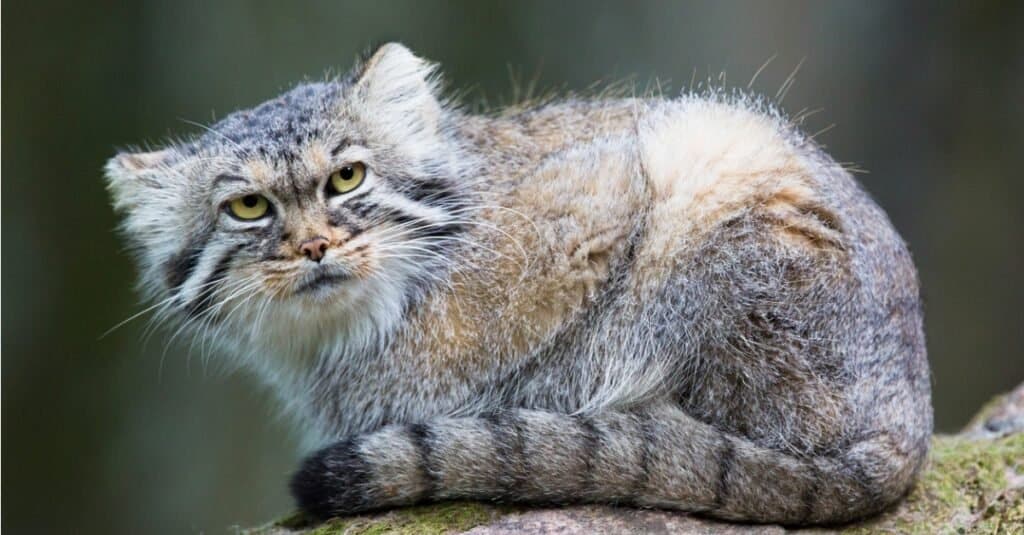Do Pallas’s cats make good pets? No! Is it even a good idea? Absolutely not! Though these adorable, pint-sized kitties have faces that could launch a thousand awws, they do not make suitable pets. These fluffy felines, hailing from the rugged landscapes of Central Asia, would bring a touch of the wild into your living room. Perhaps a touch too much. Pallas’s cats are wild animals with specific needs and behaviors adapted to their natural environment. Keeping them in a domestic setting can be stressful for the cat and challenging for the owner. Continue reading to discover more about these captivating cats and why they don’t make good pets.

Pallas’s cats live in the cold and arid steppes of central Asia.
©iStock.com/kjekol
Do Pallas’s Cats Make Good Pets? What is a Pallas’s Cat?
The Pallas’s cat (Otocolobus manul), also known as the manul, is a small wild cat native to the steppes and grasslands of Central Asia. It is named for the German naturalist Peter Simon Pallas. Pallas first described the species in 1776. Pallas’s cats have a stocky build, a short, flat face, and a dense, long coat that provides excellent insulation from the cold. Adapted to life in harsh environments, these cats are. These include the high-altitude regions of Mongolia, China, Russia, Iran, and parts of Central Asia.
Pallas’s cats are primarily solitary and are known for their elusive and solitary behavior. They are crepuscular, meaning they are most active during dawn and dusk. They feed on small mammals, birds, and insects. Pallas’s cats are considered near-threatened due to habitat loss, climate change, and poaching.

Pallas’s cats feed on small mammals, birds, and insects.
©slowmotiongli/Shutterstock.com
Do Pallas’s Cats Make Good Pets? Why It’s Not Even A Good Idea
In the immortal words of Florence Johnston, “Sit done folks, this is going to take a while.” There are so many reasons why it’s not even a good idea to keep a Pallas’s cat as a pet that I don’t even know where to begin. For starters, they are wild animals that are best observed and appreciated in their natural habitats or well-managed conservation programs. They are solitary and territorial animals. This sort of animal does not make for a good companion for you and will cause trauma to the cat. Their average territory can range 2-3 miles (3-5 km). The average home is much smaller and the cat will feel constrained. Such constraints can lead to maladaptive, possibly destructive, behaviors.
Then there is their diet to consider. These cats have specific dietary requirements that are challenging to meet in a home environment. In the wild, they feed on small mammals and birds. The majority of their diet consists of pika, a small mammal in the same order, Lagomorpha, as rabbits. While rabbits may appease a hungry wildcat, I wouldn’t bet the farm on it. And while North America is home to the American pika, they are only found in alpine terrine, above the tree line.
Solitary and Crepuscular
Assuming you are looking for a pet that will be your companion, let’s say you find a reputable and reliable pika supplier, or you discover that your Pallas’s cat is sated by rabbits, they’re still not going to be the most engaging pet. In the wild, these cuties sleep most of the day. And the night. They are most active at dawn and dusk when their principal activities are hunting, capturing, and eating prey. Playful animals, these are not. Adapted for survival they are. They are also solitary creatures. You only think you’re being rebuffed by your domesticated short hair.
Ethical Considerations and Conservation Concerns
Keeping wild animals as pets raises ethical concerns related to their well-being and the ability of private individuals to meet their specific needs in captivity. As noted, Pallas’s cats have complex behavioral and dietary requirements that are challenging to address in a home environment. From their diet to their temperament, these cats were not meant to be kept in captivity any more than their larger counterparts. if you wouldn’t consider keeping a leopard as a pet…
Pallas’s cats are considered near-threatened in the wild. Ethical breeding programs play a vital role in the conservation of endangered species like the Pallas’s cat. These programs, typically managed by accredited zoos and conservation organizations, prioritize the genetic health and well-being of the species. Through careful breeding, researchers maintain genetic diversity, contributing to the overall health of the species.
In stark contrast, the unethical pet trade poses a significant threat to the Pallas’s cat and other endangered species. Illegitimate breeding for profit often results in a lack of genetic diversity, poor living conditions, and improper care.
Five Fascinating Facts about Pallas’s Cats
- When the mercury dips below freezing, Pallas’s cats will rest their paws on their thick, furry tails to keep them warm
- When Pallas’s cats get excited the yips and squeals they emit sound more like a puppy than a cat
- Pallas’s cats are on the small size. These cute little critters are about the same size as a domestic housecat. The average weight of these cats is between 9-11 pounds (4.5-5 kg).
- Pallas’s cats have the thickest and longest fur of all feline species. This extra-luxurious protects them from the cold.
- Unlike domestic housecats which have verticle pupils, Pallas’s cats have round pupils, a feature they share with larger wildcats.
Thank you for reading! Have some feedback for us? Contact the AZ Animals editorial team.








